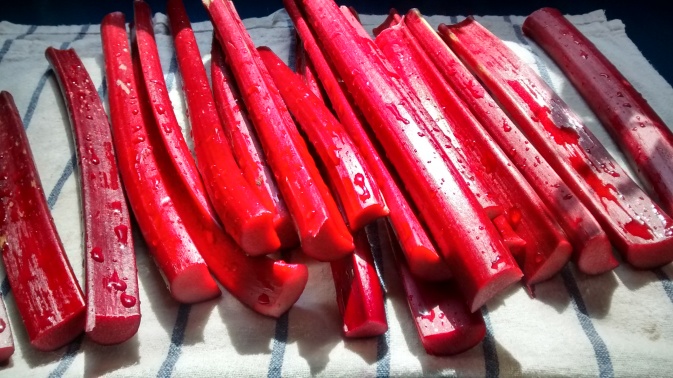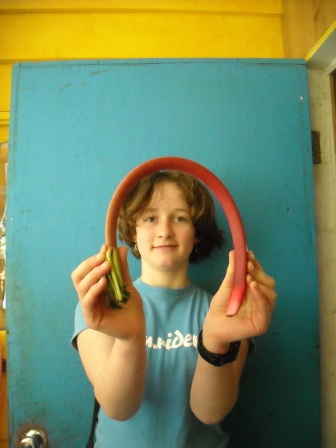Although spring is officially here, the weather continues to be cold and wet. The vegetables are getting planted, both seeds and starts, in dribs and drabs, slowly but surely. The heat-loving tomatoes, peppers, squash and basil are still indoors, under the fluorescent lights, getting bigger and bigger, just waiting for warmer temperatures outdoors, so they can get into their permanent locations under the cloches in the vegetable garden.The fruit trees in our orchard have been slow to bloom but about a week ago I noticed that the pears were finally flowering. While I worked in the garden nearby during the sunny afternoon, the plum tree’s blossom also began to open, inviting the hungry bees to come and feast. This morning the apple blossom has begun to burst from sweet pink buds.
There is at least one garden plant that really thrives in the cool, rain-soaked conditions that we are experiencing. That crop is Rheum rhabarbarum, commonly known as rhubarb.

Rhubarb was originally brought west from China, where the roots were used for medicinal purposes. By the 14th century the plant had reached Europe where it was used for its antiseptic, antispasmodic, antitumor, astringent, diuretic, laxative, purgative, stomachic, soothing and tonic properties, as well as in the kitchen where it was cooked with plenty of sugar or honey, for dessert.

Although the pink and sometimes greenish stalks are edible, the leaves are toxic, containing large amounts of oxalic acid, and should not be eaten or left where livestock may consume them. The roots of the plant can be used to produce a very dark dye for wool and other fibers, similar to that made from walnut hulls, but more readily available, especially farther north where walnut trees do not thrive.
The plants are easy to grow from seed or, more commonly, from divided roots. Rhubarb grows well in a temperate climate and requires little in the way of tending, although it is a heavy feeder, enjoying a good dose of compost or well-rotted manure in the early spring just before new growth begins. A bit of occasional weeding and regular watering (not a problem here in the rain forest!) is about all rhubarb needs to produce a large quantity of healthy stalks. It takes about three years for the plants to become fully established. The roots may be divided every now and then in order to propagate new plants or to refresh one’s rhubarb plantation. Flower stalks should be cut off before they have a chance to develop.
Browsing through my tattered old recipe folder recently, I came across a National Post clipping dated May 20, 2000. It was from the weekend Food & Drink section and featured a story by food columnist Cynthia David who wrote that “Canadians consume five million tons of rhubarb a year”! This includes the earlier forced rhubarb, grown in large, dark sheds in rural parts of the country, available from about mid-February to May, at which time the outdoor harvest normally begins. After harvesting, by hand, most commercially grown rhubarb is washed, trimmed, chopped and sent off to be processed into a variety of pre-made fruit pies, crisps and pie fillings. It is also available frozen as is or dried, sweetened and flavoured with strawberry juice.

At home, on the island, in our garden, I grow a dozen plants, which reliably produce many pounds of lovely pink rhubarb from mid-April to the end of June. We use quite a lot of this bounty ourselves, and still there is plenty to share with family and friends. The stalks freeze well; washed, dried and chopped into small pieces, bagged and placed in the freezer for future use in crumbles, pies, tarts, muffins, jams, or chutneys.

For dessert at home, we eat fruit crumble, or crisp, almost exclusively. I make this dessert with whatever fruit is in season or readily available, either individually or in combination. At the end of March we used up the last of our own fresh apples, overwintered in their slatted wooden boxes. I experimented with a frozen berry/dried apple combo, while waiting for the first fresh rhubarb of spring.
Over the years, I have experimented with different ways to prepare rhubarb. I have learned that a small handful of chopped sweet cicely (an anise-flavoured, fern-like garden herb) added to the prepared stalks before cooking helps to cut the acidity, allowing for a reduction in the amount of sugar required for sweetening.

In my experience, the following recipes are all vastly superior to the childhood favourite of munching on a raw stick of rhubarb dipped repeatedly into the sugar bowl. Perhaps I’ll do some baking while I wait for the weather to improve.
Rhubarb Crumble
6 cups rhubarb, cut into 1-inch cubes (fresh or frozen)
¾ cup granulated sugar 
2 Tbsp. all-purpose flour
½ tsp. cinnamon, ginger, lemon or orange rind (optional)
Topping:
½ cup all-purpose flour
½ cup brown sugar
1 cup porridge oats (I use slow cooking ones)
A pinch of grated nutmeg
1/3 cup cold butter, cut into chunks
Preheat oven to 375 F. (190 C). Using a large bowl toss together rhubarb, sugar, flour and flavouring, if desired. Place in a 2 litre non-reactive (glass, ceramic or stainless steel) baking dish.
Using the same large bowl, mix the dry ingredients for topping. Add the butter and rub into dry ingredients using clean fingertips until mixture is crumbly.
Sprinkle topping over rhubarb and bake until topping is golden brown and filling is bubbly and tender, about 35 minutes. Serve warm or cool with vanilla ice-cream, whipped cream or yogurt.
Rhubarb Dessert Cake
2/3 cup oil (canola, sunflower or other cooking oil)
¾ cup brown sugar 
1 beaten egg
½ cup sour milk
1 tsp. vanilla extract
2 ¼ cups all-purpose flour
1 ½ tsp. baking soda
3 cups chopped fresh (or frozen) rhubarb
Topping:
2 Tbsp. granulated sugar
1-2 tsp. ground cinnamon
Preheat oven to 350 F. In a large mixing bowl, cream together oil and brown sugar. Beat in egg and vanilla extract. In a separate bowl, whisk or sift together flour and baking soda and add to the creamed mixture, alternating with the sour milk. Mix well after each addition. Stir in chopped rhubarb and spoon into a greased 9 inch square cake pan, scraping out the bowl with a rubber spatula. Mix the sugar and cinnamon for topping and sprinkle over the cake batter. Bake for 50-60 minutes or until a toothpick inserted in centre of cake comes out clean. Serve warm or cool with or without ice-cream, whipped cream or yogurt.
Rhubarb Dream Bars
1½ cups all-purpose flour
¾ cup powdered confectioner’s sugar
¼ tsp. salt
1 tsp. grated lemon zest
2/3 cup cold butter, cut into chunks
1 tsp. lemon juice
Filling:
4 eggs
¼ tsp. salt
1 cup sugar
½ cup all-purpose flour
4 cups packed diced rhubarb
Small handful chopped sweet cicely leaves (optional)
Preheat oven to 350 F. Whisk dry ingredients for crust. Cut in butter as for pastry. Add lemon zest and juice. Press into bottom of a 9 x 13 inch pan. Bake 10-15 minutes.
For filling, beat eggs and salt until foamy. Add sugar gradually beating until thick and light yellow in colour. Blend in flour and fold in rhubarb. Pour over warm crust in pan. Return to oven and bake for 40-45 minutes or until lightly browned. Cut into bars to serve, warm or at room temperature.
Cold Rhubarb Tea
4 cups diced rhubarb (do not peel) 
4 cups water
Grated rind of 1 lemon or orange
¾ to 1 cup granulated sugar
Plain or sparkling water (optional, to taste)
Simmer rhubarb in water until very tender, about 20-25 minutes. Strain, add grated lemon or orange rind and sugar. Stir until sugar has dissolved. Cool well and serve over ice in a tall glass, as is or diluted to taste with plain or sparkling water.
This beverage may also be preserved by pouring hot into a hot, sterilized canning jar then sealing by processing in a boiling water bath for 10 minutes. In this case do not add grated citrus rind until ready to use.
Rhubarb Chutney
2 pounds rhubarb (7 cups chopped)
1 large onion
1 cup vinegar
1 ¼ cups granulated sugar
¾ tsp. salt
1 tsp. ground ginger
1 tsp. ground cinnamon
¼ tsp. ground cloves
¼ tsp. ground allspice
Small pinch of cayenne pepper
1 tsp. whole pickling spice (tied in a cheesecloth bag)
Wash and cut rhubarb into ½ inch pieces. Peel and slice onion. Combine rhubarb, onion and vinegar and cook, uncovered, for 20 minutes. Add remaining ingredients and cook, uncovered, until the chutney is of a jam-like consistency, about 40 minutes, stirring to prevent scorching. Pour into hot, sterilized jars and seal by processing in a boiling water bath for 10 minutes. Yield: about 3 ½ cups. Serve with curries, cold meats, cheeses, etc.














Really enjoying your stories Claudia
LikeLike
Thanks Jamie, It’s nice that you are reading them, glad you are enjoying as well!
LikeLike
Great post. Wish I had some fresh rhubarb to try that crisp! Ironically, I was licking a Whole food’s rhubarb /berry ice pop while reading this post…really!
LikeLiked by 2 people
Really! That is hilarious! I never knew that such a thing exists. It sounds tasty! I wonder what/if rhubarb sorbet or ice-cream has been invented yet? Thanks for reading, glad you enjoyed!
LikeLiked by 1 person
I meant Amazin’….
LikeLiked by 1 person
I know you did Darlin’….
LikeLike
I did a big harvest on Sunday from our patch at the farm – some of which came from you about five years ago. I froze most of it – I’m experimenting with blanching in a heavy sugar syrup then freezing in small bags, because I find freezing it without it tends to get freezer burnt quickly. I’ll let you know how that goes! And of course I made a batch of Rude Stewbarb. I added a few frozen raspberries at the end – it’s surprising how their flavour comes through.
LikeLiked by 1 person
That sounds great! I like the simpler way of freezing, just chopped and straight into the freezer, but perhaps I use it up before it has a chance to become freezer burnt. Raspberry and rhubarb crumble is a good combination too! See you soon!
LikeLike
Have you seen Susan Musgrave’s book, A Taste of Haida Gwaii? If not, you must check it out as this is where you can go with your blog in a couple of years…you heard it here first!
LikeLiked by 1 person
Hi Sally! As a matter of fact, I have just finished reading that fab book! Loved it, and would highly recommend it as a great read, with wonderful photographs and priceless humour. Thank you for the vote of confidence. Oh, and I am about to try and make Susan Musgrave’s elderflower cordial, using our native western elderflowers. Will you call the Coast Guard for us if we end up poisoning ourselves!
LikeLike
Look at all that wonderful rhubarb. Mine is growing in a pot so it doesn’t get that big. I picked my first three stalks today. Since I have to wait for more I froze them. Thanks for the great recipes. – Margy
LikeLiked by 1 person
I saw the picture of your rhubarb growing in a pot; that looks good too! I hope you soon get more stalks to add to your collection in the freezer! I recently read that rhubarb will grow well in a container, especially if fed well, and in a cooler climate. No worries there! Maybe another pot or two eventually?
LikeLike
My mother grew rhubarb when I was growing up, and even though I didn’t care for the rhubarb sauce that she used to make in batches and freeze, I did love the rhubarb custard pie she made. It was from a Betty Crocker cookbook from the 1940s or 50s, and seeing your photo and recipe for the Rhubarb Dream Bars reminds me of it. Mmmm. 🙂
Your post taught me a lot about rhubarb that I didn’t know. (I had no idea it was so popular in Canada!). Thank you for the lovely read, and also for your recent visit to my blog.
LikeLiked by 1 person
Hi Suzanne,
Thanks for your comment about the rhubarb story. I was sure I had already replied, but apparently not! That Rhubarb Bar recipe tastes just like the old-fashioned rhubarb pie recipe in the Betty Crocker recipe book. I also remember this from childhood days; we had a neighbour who, among many other things, used to make that delicious pie.
I also enjoyed reading your blog and have signed on to follow it; well written and interesting as well. I hope you are enjoying favourable summer weather now!
LikeLike
I inherited rhubarb when I moved into my new home. There are 2 large bushes. They are not the lovely red color I am used to, though. They are green. When I stewed some, it tasted the same as I’ve had before. I froze all the stalks from one bush, and will get onto the other one soon. I put a garden update on my blog. https://beckyathome.wordpress.com/2017/06/06/garden-update-june-6-2017/
On another post, I put the pictures of the rhubarb blooming. I’ve never had it happen before. In years past, I’ve always broken or cut off the blooms when they first come on, but I didn’t get to it in time, so it bloomed. https://beckyathome.wordpress.com/2017/05/21/saving-money-may-21-2017-a-week-of-simple-pleasures/ The pictures of it blooming are on this post from May 21.
LikeLiked by 1 person
Looks good Becky! By cutting off the rhubarb’s flower bud you encourage production of edible rhubarb stalks; I think the root of the plant will become depleted using up energy to produce that massive flower, although it is rather interesting and beautiful in its own way. Perhaps a good dose of manure for the rhubarb plants will help rejuvenate them. Also dividing the roots every few years can help to produce more stalks in future.
LikeLiked by 1 person
I was delighted to pick enough rhubarb to make jam a few days ago. I’ve cleaned off both rhubarb bushes now and they are already growing back😄
LikeLike
That’s great Becky! Don’t forget to give them lots of compost or manure for next year.
LikeLiked by 1 person
wish i had a piece of rhubarb to make a rhubarb crumble and then gobble it up! i suppose there is no chance of growing it in mexico?!
LikeLike
I wish you had some rhubarb too! It might grow in your part of Mexico, where it is cooler at night at least. You could try one of the seed suppliers like West Coast Seeds, look them up online, they sell mail order seeds. Apparently rhubarb is quite easy to grow from seed although I have never done so. Thanks for following my blog!
LikeLike